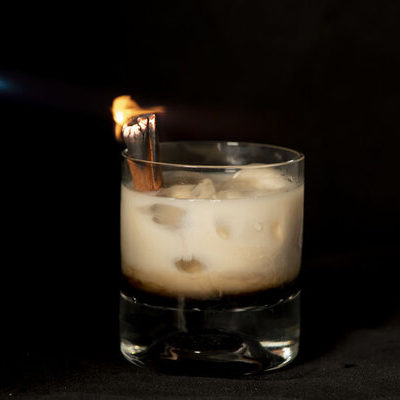
Sambuca
What is Sambuca?
Sambuca is an alcoholic beverage of Italian origin with a distinct licorice flavor, typically made from star anise and elderberry.
- This drink is usually colorless and often enjoyed as a digestif after a meal, contrary to the Greek aperitif Ouzo.
- The most common variety of this drink is called white sambuca to differentiate it from other varieties that are blue in color (black variety) or bright red (red variety).
Some of the most popular varieties of this drink include: bottega, cello, eros, galliano, luxardo, molinari, opal nera black, ramazzotti, romana, zambello, and antica.
The top 10 most popular brands of this drink in the US are:
- Molinari Sambuca Extra
- Luxardo Sambuca dei Cesari
- Meletti Anisetta & Sambuca
- Antica
- Romana
- Antica Black
- Borghetti
- Lazzaroni 1851
- Di Angela
- Romana Black
Origin of sambuca
Sambuca’s etymology is a much debated topic. Its name is derived from the Latin word for “elderberry.” However, while this drink sometimes features elderberry, it isn’t necessarily always an ingredient. Some argue that the word comes from “Zammut,” an Arabic anise-flavored drink imported via the Italian port of Civitavecchia. As this is also sambuca’s birthplace, it is arguable that this best explains the origin.
Indeed, this drink was first commercially produced in Italy by Luigi Manzi in 1851. He believed that this fine anisette was beneficial for the stomach after eating. It is said that Manzi named it after a group of watermen known as “sambuchelli” who worked between Ischia island and Naples. In 1945, Angelo Molinari began producing his own sambuca for the international market, which launched its worldwide reputation today.
Function
Sambuca combines well with any number of spirits. Besides serving as an after-dinner drink on its own, this drink can be added to coffee as a sweetener—and fortifier. Also, it is not uncommon to find this alcoholic beverage as an ingredient in cookies, cakes, and a variety of desserts.
Nutrition
In a 30 ml serving of sambuca, there are:

This alcoholic beverage may provide some health benefits. These include lowering blood pressure and helping to control diabetes. Furthermore, it is thought that sambuca can help prevent heart disease, cancer, and infections. Nonetheless, several health issues like high blood pressure, stroke, heart attack, heart failure, liver damage, diabetes, and diarrhea have been associated with consuming too much alcohol.
Commercial Production
The commercial production of this beverage can include alcohol or distillation of agricultural origin or one or more spirits. This beverage contains distillates of anise, star anise, and other aromatic herbs. Firstly, demineralized water is heated to around 150°F and is combined with the sugar to produce a syrup. This drink contains a significant amount of sugar, which equates to an average of 47 ounces per gallon (350 grams per liter). Afterwards, the star anise is blanched and then ground.
Then, steam distillation is applied to extract this spice’s essential oil. However, the majority of sambuca producers often import the star anise from China, as it is an integral ingredient, and rarely undertake the process themselves. Lastly, the ingredients are combined and left to rest for just under a week in large steel tanks. Once the mixture has settled, it is always filtered at room temperature as chill-filtering would cause a louche effect and remove the essential oils. In 2021, the revenue from the spirits sector in the USA is expected to reach $84.448 million. This market is estimated to grow at a rate of 6.1% over the next four years.
Application
It is possible to make this alcoholic beverage at home. First, collect a large jug and pour in the vodka. Next, measure the aniseed extract, add it to the vodka, and stir the mixture. Then, add the sugar syrup, mix again and pour into serving bottles. Chill in the fridge until you are ready to enjoy this drink.
This beverage is served neat, garnished with three coffee beans in each glass or as part of a lovely sambuca-based cocktail. For best results, store this liquor in a cool, dark place away from heat. As the alcohol in this beverage keeps it from freezing, you can also store it in a freezer to keep it chilled.
Sambuca recipes
This drink is well-known for its flavor. Some popular recipes with this alcohol include:
- Fairy’s Flower Lemonade
- Blueberry and Sambuca Pops
- Raspberry-Basil Sambuca Martini
- Anaconda Shooter
- Coffee Sambuca
FDA Regulation
The FDA has no regulations regarding this beverage. However, the Alcohol and Tobacco Tax and Trade Bureau regulate the labeling and advertising of spirits like sambuca and classify this drink under the liqueurs and cordials class. The TTB permits certain cordials or liqueurs like sambuca to be designated with a name familiar with the customers. The labels “cordials or liqueurs’ are not required. In 2018, the TTB proposed to change this by adding a category like flavored spirits within this designation.
References
Wiesen. “What Is Sambuca?” Delighted Cooking, www.delightedcooking.com/what-is-sambuca.htm
“Spirits – United States: Statista Market Forecast.” Statista, www.statista.com/outlook/10020000/109/spirits/united-states#market-globalRevenue
Pietrangelo, Ann. “23 Effects of Alcohol on Your Body.” Healthline, Healthline Media, 29 Sept. 2018, www.healthline.com/health/alcohol/effects-on-body#Digestive-system
